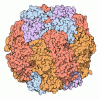[English] 日本語
 Yorodumi
Yorodumi- PDB-6z1g: CryoEM structure of the interaction between Rubisco Activase smal... -
+ Open data
Open data
- Basic information
Basic information
| Entry | Database: PDB / ID: 6z1g | ||||||
|---|---|---|---|---|---|---|---|
| Title | CryoEM structure of the interaction between Rubisco Activase small-subunit-like (SSUL) domain with Rubisco from Nostoc sp. (strain PCC7120) | ||||||
 Components Components |
| ||||||
 Keywords Keywords | PHOTOSYNTHESIS / beta barrel | ||||||
| Function / homology |  Function and homology information Function and homology informationphotorespiration / carboxysome / ribulose-bisphosphate carboxylase / ribulose-bisphosphate carboxylase activity / reductive pentose-phosphate cycle / monooxygenase activity / magnesium ion binding / ATP hydrolysis activity / ATP binding Similarity search - Function | ||||||
| Biological species |  Nostoc sp. (bacteria) Nostoc sp. (bacteria) | ||||||
| Method | ELECTRON MICROSCOPY / single particle reconstruction / cryo EM / Resolution: 8.2 Å | ||||||
 Authors Authors | Wang, H. / Bracher, A. / Flecken, M. / Popilka, L. / Hartl, F.U. / Hayer-Hartl, M. | ||||||
 Citation Citation |  Journal: Cell / Year: 2020 Journal: Cell / Year: 2020Title: Dual Functions of a Rubisco Activase in Metabolic Repair and Recruitment to Carboxysomes. Authors: Mirkko Flecken / Huping Wang / Leonhard Popilka / F Ulrich Hartl / Andreas Bracher / Manajit Hayer-Hartl /  Abstract: Rubisco, the key enzyme of CO fixation in photosynthesis, is prone to inactivation by inhibitory sugar phosphates. Inhibited Rubisco undergoes conformational repair by the hexameric AAA+ chaperone ...Rubisco, the key enzyme of CO fixation in photosynthesis, is prone to inactivation by inhibitory sugar phosphates. Inhibited Rubisco undergoes conformational repair by the hexameric AAA+ chaperone Rubisco activase (Rca) in a process that is not well understood. Here, we performed a structural and mechanistic analysis of cyanobacterial Rca, a close homolog of plant Rca. In the Rca:Rubisco complex, Rca is positioned over the Rubisco catalytic site under repair and pulls the N-terminal tail of the large Rubisco subunit (RbcL) into the hexamer pore. Simultaneous displacement of the C terminus of the adjacent RbcL opens the catalytic site for inhibitor release. An alternative interaction of Rca with Rubisco is mediated by C-terminal domains that resemble the small Rubisco subunit. These domains, together with the N-terminal AAA+ hexamer, ensure that Rca is packaged with Rubisco into carboxysomes. The cyanobacterial Rca is a dual-purpose protein with functions in Rubisco repair and carboxysome organization. | ||||||
| History |
|
- Structure visualization
Structure visualization
| Movie |
 Movie viewer Movie viewer |
|---|---|
| Structure viewer | Molecule:  Molmil Molmil Jmol/JSmol Jmol/JSmol |
- Downloads & links
Downloads & links
- Download
Download
| PDBx/mmCIF format |  6z1g.cif.gz 6z1g.cif.gz | 218.4 KB | Display |  PDBx/mmCIF format PDBx/mmCIF format |
|---|---|---|---|---|
| PDB format |  pdb6z1g.ent.gz pdb6z1g.ent.gz | 172.6 KB | Display |  PDB format PDB format |
| PDBx/mmJSON format |  6z1g.json.gz 6z1g.json.gz | Tree view |  PDBx/mmJSON format PDBx/mmJSON format | |
| Others |  Other downloads Other downloads |
-Validation report
| Summary document |  6z1g_validation.pdf.gz 6z1g_validation.pdf.gz | 382 KB | Display |  wwPDB validaton report wwPDB validaton report |
|---|---|---|---|---|
| Full document |  6z1g_full_validation.pdf.gz 6z1g_full_validation.pdf.gz | 392 KB | Display | |
| Data in XML |  6z1g_validation.xml.gz 6z1g_validation.xml.gz | 22.7 KB | Display | |
| Data in CIF |  6z1g_validation.cif.gz 6z1g_validation.cif.gz | 34.8 KB | Display | |
| Arichive directory |  https://data.pdbj.org/pub/pdb/validation_reports/z1/6z1g https://data.pdbj.org/pub/pdb/validation_reports/z1/6z1g ftp://data.pdbj.org/pub/pdb/validation_reports/z1/6z1g ftp://data.pdbj.org/pub/pdb/validation_reports/z1/6z1g | HTTPS FTP |
-Related structure data
| Related structure data |  11029MC  6hasC  6z1dC  6z1eC  6z1fC M: map data used to model this data C: citing same article ( |
|---|---|
| Similar structure data |
- Links
Links
- Assembly
Assembly
| Deposited unit | 
|
|---|---|
| 1 | 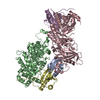
|
- Components
Components
| #1: Protein | Mass: 10266.549 Da / Num. of mol.: 1 / Fragment: SSUL domain Source method: isolated from a genetically manipulated source Source: (gene. exp.)  Nostoc sp. (strain PCC 7120 / SAG 25.82 / UTEX 2576) (bacteria) Nostoc sp. (strain PCC 7120 / SAG 25.82 / UTEX 2576) (bacteria)Gene: rca, alr1533 / Plasmid: pHUE / Production host:  | ||
|---|---|---|---|
| #2: Protein | Mass: 53112.125 Da / Num. of mol.: 2 Source method: isolated from a genetically manipulated source Source: (gene. exp.)  Nostoc sp. (strain PCC 7120 / SAG 25.82 / UTEX 2576) (bacteria) Nostoc sp. (strain PCC 7120 / SAG 25.82 / UTEX 2576) (bacteria)Gene: cbbL, rbc, rbcA, rbcL, alr1524 / Plasmid: pET11a-NosGroSEL-H6ubi-NosLS / Cell line (production host): STAR / Production host:  References: UniProt: P00879, ribulose-bisphosphate carboxylase #3: Protein | Mass: 12840.725 Da / Num. of mol.: 2 Source method: isolated from a genetically manipulated source Source: (gene. exp.)  Nostoc sp. (strain PCC 7120 / SAG 25.82 / UTEX 2576) (bacteria) Nostoc sp. (strain PCC 7120 / SAG 25.82 / UTEX 2576) (bacteria)Gene: cbbS, rbcS, alr1526 / Plasmid: pET11a-NosGroSEL-H6ubi-NosLS / Cell line (production host): STAR / Production host:  References: UniProt: P06514, ribulose-bisphosphate carboxylase |
-Experimental details
-Experiment
| Experiment | Method: ELECTRON MICROSCOPY |
|---|---|
| EM experiment | Aggregation state: PARTICLE / 3D reconstruction method: single particle reconstruction |
- Sample preparation
Sample preparation
| Component |
| |||||||||||||||||||||||||||||||||||
|---|---|---|---|---|---|---|---|---|---|---|---|---|---|---|---|---|---|---|---|---|---|---|---|---|---|---|---|---|---|---|---|---|---|---|---|---|
| Molecular weight |
| |||||||||||||||||||||||||||||||||||
| Source (natural) |
| |||||||||||||||||||||||||||||||||||
| Source (recombinant) |
| |||||||||||||||||||||||||||||||||||
| Buffer solution | pH: 8.4 | |||||||||||||||||||||||||||||||||||
| Buffer component |
| |||||||||||||||||||||||||||||||||||
| Specimen | Conc.: 4.9 mg/ml / Embedding applied: NO / Shadowing applied: NO / Staining applied: NO / Vitrification applied: YES Details: For Preparing the NosRca:Rubisco complex, NosRubisco (1.25 uM) was mixed with NosRca (15 uM). | |||||||||||||||||||||||||||||||||||
| Specimen support | Grid material: COPPER / Grid mesh size: 300 divisions/in. / Grid type: Quantifoil R2/1 | |||||||||||||||||||||||||||||||||||
| Vitrification | Instrument: FEI VITROBOT MARK IV / Cryogen name: ETHANE / Humidity: 95 % / Chamber temperature: 298 K |
- Electron microscopy imaging
Electron microscopy imaging
| Microscopy | Model: TFS GLACIOS |
|---|---|
| Electron gun | Electron source:  FIELD EMISSION GUN / Accelerating voltage: 200 kV / Illumination mode: SPOT SCAN FIELD EMISSION GUN / Accelerating voltage: 200 kV / Illumination mode: SPOT SCAN |
| Electron lens | Mode: BRIGHT FIELD |
| Image recording | Average exposure time: 12 sec. / Electron dose: 47 e/Å2 / Film or detector model: GATAN K2 SUMMIT (4k x 4k) / Num. of grids imaged: 1 / Num. of real images: 1570 / Details: 40 frames per image |
- Processing
Processing
| EM software |
| ||||||||||||||||||||||||||||||||||||||||
|---|---|---|---|---|---|---|---|---|---|---|---|---|---|---|---|---|---|---|---|---|---|---|---|---|---|---|---|---|---|---|---|---|---|---|---|---|---|---|---|---|---|
| CTF correction | Type: PHASE FLIPPING AND AMPLITUDE CORRECTION | ||||||||||||||||||||||||||||||||||||||||
| Particle selection | Num. of particles selected: 298336 | ||||||||||||||||||||||||||||||||||||||||
| Symmetry | Point symmetry: C1 (asymmetric) | ||||||||||||||||||||||||||||||||||||||||
| 3D reconstruction | Resolution: 8.2 Å / Resolution method: FSC 0.143 CUT-OFF / Num. of particles: 32128 / Symmetry type: POINT | ||||||||||||||||||||||||||||||||||||||||
| Atomic model building | Protocol: RIGID BODY FIT |
 Movie
Movie Controller
Controller





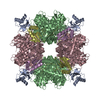

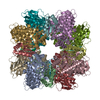
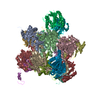


 PDBj
PDBj